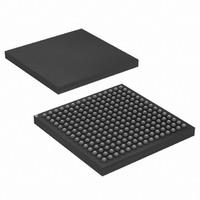AT91CAP7E-NA-ZJ Atmel, AT91CAP7E-NA-ZJ Datasheet - Page 103

AT91CAP7E-NA-ZJ
Manufacturer Part Number
AT91CAP7E-NA-ZJ
Description
MCU CAP7 FPGA 225LFBGA
Manufacturer
Atmel
Series
CAP™r
Specifications of AT91CAP7E-NA-ZJ
Core Processor
ARM7
Core Size
16/32-Bit
Speed
80MHz
Connectivity
EBI/EMI, FPGA, IrDA, SPI, UART/USART, USB
Peripherals
DMA, POR, PWM, WDT
Number Of I /o
32
Program Memory Size
256KB (256K x 8)
Program Memory Type
ROM
Ram Size
160K x 8
Voltage - Supply (vcc/vdd)
1.08 V ~ 1.32 V
Data Converters
A/D 8x10b
Oscillator Type
Internal
Operating Temperature
-40°C ~ 85°C
Package / Case
225-LFBGA
Processor Series
AT91Mx
Core
ARM7TDMI
Data Bus Width
32 bit
3rd Party Development Tools
JTRACE-ARM-2M, MDK-ARM, RL-ARM, ULINK2
Lead Free Status / RoHS Status
Lead free / RoHS Compliant
Eeprom Size
-
Lead Free Status / Rohs Status
Details
Available stocks
Company
Part Number
Manufacturer
Quantity
Price
- Current page: 103 of 520
- Download datasheet (11Mb)
19. Bus Matrix
19.1
19.2
19.3
19.3.1
19.3.2
19.3.3
8549A–CAP–10/08
Description
Memory Mapping
Special Bus Granting Mechanism
No Default Master
Last Access Master
Fixed Default Master
The Bus Matrix implements a multi-layer AHB, based on the AHB-Lite protocol, that enables par-
allel access paths between multiple AHB masters and slaves in a system, thus increasing the
overall bandwidth. The Bus Matrix interconnects up to 4 AHB Masters to up to 8 AHB Slaves.
The normal latency to connect a master to a slave is one cycle except for the default master of
the accessed slave which is connected directly (zero cycle latency). The Bus Matrix user inter-
face is compliant with ARM
(MATRIX_SFR) that allow the Bus Matrix to support application specific features.
The Bus Matrix provides one decoder for every AHB Master Interface. The decoder offers each
AHB Master several memory mappings. In fact, depending on the product, each memory area
may be assigned to several slaves. Booting at the same address while using different AHB
slaves (i.e. external RAM, internal ROM or internal Flash, etc.) becomes possible.
The Bus Matrix user interface provides Master Remap Control Register (MATRIX_MRCR) that
performs remap action for every master independently.
The Bus Matrix provides some speculative bus granting techniques in order to anticipate access
requests from some masters. This mechanism reduces latency at first access of a burst or single
transfer. This bus granting mechanism sets a different default master for every slave.
At the end of the current access, if no other request is pending, the slave remains connected to
its associated default master. A slave can be associated with three kinds of default masters: no
default master, last access master and fixed default master.
At the end of the current access, if no other request is pending, the slave is disconnected from
all masters. No Default Master suits low-power mode.
At the end of the current access, if no other request is pending, the slave remains connected to
the last master that performed an access request.
At the end of the current access, if no other request is pending, the slave connects to its fixed
default master. Unlike last access master, the fixed master does not change unless the user
modifies it by a software action (field FIXED_DEFMSTR of the related MATRIX_SCFG).
To change from one kind of default master to another, the Bus Matrix user interface provides the
Slave Configuration Registers, one for each slave, that set a default master for each slave. The
Slave Configuration Register contains two fields: DEFMSTR_TYPE and FIXED_DEFMSTR. The
2-bit DEFMSTR_TYPE field selects the default master type (no default, last access master, fixed
default master), whereas the 4-bit FIXED_DEFMSTR field selects a fixed default master pro-
vided that DEFMSTR_TYPE is set to fixed default master. Please refer to the Bus Matrix user
interface description.
®
Advance Peripheral Bus and provides 6 Special Function Registers
AT91CAP7E
103
Related parts for AT91CAP7E-NA-ZJ
Image
Part Number
Description
Manufacturer
Datasheet
Request
R

Part Number:
Description:
Customizable Microcontroller
Manufacturer:
ATMEL Corporation
Datasheet:

Part Number:
Description:
DEV KIT FOR AVR/AVR32
Manufacturer:
Atmel
Datasheet:

Part Number:
Description:
INTERVAL AND WIPE/WASH WIPER CONTROL IC WITH DELAY
Manufacturer:
ATMEL Corporation
Datasheet:

Part Number:
Description:
Low-Voltage Voice-Switched IC for Hands-Free Operation
Manufacturer:
ATMEL Corporation
Datasheet:

Part Number:
Description:
MONOLITHIC INTEGRATED FEATUREPHONE CIRCUIT
Manufacturer:
ATMEL Corporation
Datasheet:

Part Number:
Description:
AM-FM Receiver IC U4255BM-M
Manufacturer:
ATMEL Corporation
Datasheet:

Part Number:
Description:
Monolithic Integrated Feature Phone Circuit
Manufacturer:
ATMEL Corporation
Datasheet:

Part Number:
Description:
Multistandard Video-IF and Quasi Parallel Sound Processing
Manufacturer:
ATMEL Corporation
Datasheet:

Part Number:
Description:
High-performance EE PLD
Manufacturer:
ATMEL Corporation
Datasheet:

Part Number:
Description:
8-bit Flash Microcontroller
Manufacturer:
ATMEL Corporation
Datasheet:

Part Number:
Description:
2-Wire Serial EEPROM
Manufacturer:
ATMEL Corporation
Datasheet:











